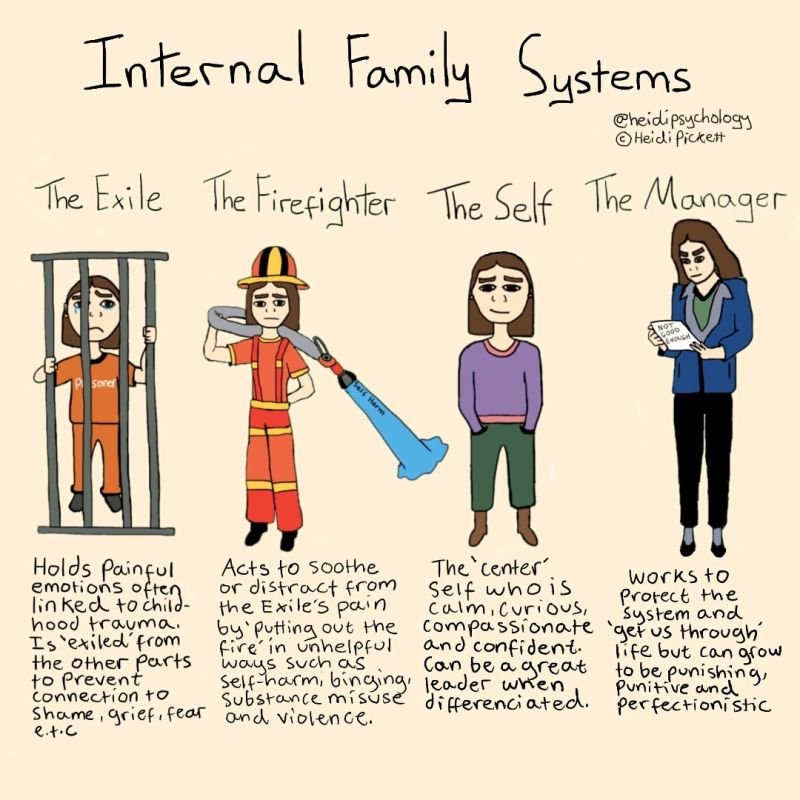Richard Schwartz’s book You Are the One You’ve Been Waiting For offers a brilliantly simple yet revolutionary approach to relationships and personal healing. Our deepest wounds and relationship struggles stem from unprocessed parts within us, which we often mistakenly identify as our core self. The idea that there is a true Self and accumulated parts that have joined it throughout life resonates with me. The fact that we can negotiate with these parts gives me hope.
We often seek partners to fill our inner voids or solve our problems instead of taking responsibility for our own well-being and becoming our own primary source of support. Healthy relationships are possible when each partner takes responsibility for their emotional state and acts as a secondary caretaker in the relationship rather than a savior. Partners help each other recognize areas for growth, but the responsibility for working through them lies with each individual.
Our Western culture, and many of the relationship experts in it, have issued us faulty maps and improper tools. We’ve been told that the love we need is a buried treasure hidden in the heart of a special intimate partner. Once we find that partner, the love we crave should flow elixir-like, filling our empty spaces and healing our pain. When that love stops flowing, even momentarily, we get scared and go to work on one of three projects. The first two of these are designed to get our partner back into that loving redeemer role. The third project is to give up on that endeavor and find alternatives.
Richard Schwartz – You Are the One You’ve Been Waiting For
Internal Family Systems, IFS
Richard Schwartz developed the Internal Family Systems (IFS) therapeutic method in the 1980s. While working as a family therapist, he noticed that his clients described their inner conflicts as if their personalities were made up of different “parts.” This observation inspired him to create IFS—a framework that views the psyche as a system of subpersonalities (or “parts”) that interact with each other much like family members.
Have you ever noticed that sometimes it feels like you’re not living with just one partner, but with several different personalities within them? This can be seen in their words, energy, facial expressions, or body language. Sometimes it’s a shift between ego states, sometimes it’s our “parts,” and sometimes it’s archetypes. One day, all these theories may finally come together into a unified understanding of human complexity.
Although the idea of internal parts is not new—similar concepts exist in Jungian psychology (archetypes) and Gestalt therapy (dialogue with different aspects of the self)—Schwartz was the first to formalize IFS as a structured therapeutic model. His main discovery was the realization that every person has a core—Self—a calm, compassionate, and wise inner leader capable of healing wounded parts. Übermensch).
Multiple personality disorder association
The concept of subpersonalities reminded me of Dissociative Identity Disorder (DID) (formerly known as “multiple personality disorder”). From the IFS perspective, DID can be seen as an extreme case of what happens when different “parts” of the psyche become so fragmented that they function as separate personalities.
In the IFS model, everyone has internal parts, but in DID, the fragmentation is so strong (often due to severe trauma) that these parts are fully separated from each other, each with its own name, memories, and abilities. This occurs because the core Self cannot integrate or manage the system due to excessive traumatic load. Each part (or “alter”) takes on a protective role, but instead of cooperating within a unified inner structure, they act as separate personalities.
IFS does not equate regular internal parts with DID but views it as an extreme survival mechanism. The goal of DID therapy based on IFS is to help these parts begin communicating with each other, reduce fear, and gradually restore leadership to the core Self, so the person can experience more internal harmony.
Key ideas and concepts
Sustaining intimacy wouldn’t be such a big problem if you had been encouraged by your family or culture to take care of your exiles. Unfortunately, however, few people know about this secret to relationship success. It is likely that your family taught you the opposite in certain situations—to lock away your parts when they felt hurt, needy, ashamed, or otherwise in pain. Then Western culture bombarded you with messages about how great it would be when you finally found your “soul mate.”
Richard Schwartz – You Are the One You’ve Been Waiting For
Internal Family Systems (IFS) and its role in relationships

Schwartz presents IFS as a model of the mind, where each of us has:
- Core-Self – a compassionate, wise inner leader that is naturally capable of guiding our psyche.
- Parts (subpersonalities) – some carry pain (Exiles), while others protect us (Managers and Firefighters).
In relationships, these wounded parts often take over, leading to conflicts, defensive reactions, and emotional triggers. Healing occurs when we turn to our Self and help the parts feel safe and integrate by listening to their needs.
Self-leadership
Richard Schwartz uses the term “self-leadership” to describe a state in which a person is guided by their Self — their core, unblemished essence — rather than by the protective or wounded subpersonalities (or “parts”) that we acquire throughout life.
Key aspects of self-leadership:
Centering in one’s Self – a person acts from their true Self, characterized by the qualities known as the “8 Cs”: calmness, curiosity, compassion, confidence, courage, clarity, creativity, and connectedness.
Harmonizing parts – instead of being influenced by protective or reactive parts (e.g., internal critics, managers, or exiles), the Self takes on the role of a compassionate leader, allowing all parts to be heard and valued.
Inner balance – the person is able to manage their emotions and reactions without being overwhelmed by any single part.
Healing and integration – in a state of self-leadership, the person helps their wounded parts heal and creates a more integrated, harmonious internal system.
The Myth of the “One”
The book challenges the idea that a romantic partner should fulfill all our emotional needs. Instead of seeking approval externally, Schwartz suggests developing self-acceptance and working on unmet childhood needs.
The role of “Exiles” in romantic relationships
For now, know that it is possible to live with your partner in a very different way. When one of you gets hurt, you both focus inside, find the parts involved, witness what those parts want you to know about their current and past pain, and share your discoveries with each other. In doing so, you are clearing your minefields by stepping on the land mines each of you brought to the relationship and then defusing them so they won’t explode again. By stepping on your land mines, your partner becomes your valued tor-mentor—they mentor you by tormenting you. Without them, you wouldn’t be able to find many of the exiles you need to heal. And as you become comfortable speaking to them about your inner experiences with your exiles, after following the trailheads they reveal, you will find their loving acceptance and support sublime. Together you will share a vulnerable and rewarding form of intimacy as partners on a journey of mutual healing and growth. You will be helping each other find and rescue your basement children. Once released, those grateful, delightful inner children form a powerful bond between you that can override the typical irritations and differences that exist in all committed relationships.
Richard Schwartz – You Are the One You’ve Been Waiting For
Exiles are parts of us that carry the pain of the past, usually related to childhood trauma, rejection, or neglect. When they are activated in relationships, they trigger strong emotional reactions. Instead of suppressing them, Schwartz advises befriending them and healing them.
For example, Maryna felt unnoticed in her childhood due to her parents’ indifference. Now, when her partner Max is late from work and doesn’t text her, she reacts strongly, feeling the pain of rejection. This is her “Exile” – the part that holds the trauma. Instead of blaming, Maryna can become aware of this pain, calm herself, and openly share her feelings.
Protective parts and their impact
Because our exiles are so desperate, easily hurt, and terrifying to us when they are upset, we have other parts that protect them by using one of the three projects: (1) changing our partner, (2) changing ourselves to please our partner, or (3) giving up on our partner and distracting or numbing.
Richard Schwartz – You Are the One You’ve Been Waiting For
To avoid pain, we develop Defenders, which manifest as:
- Managers – who control the situation, people-please, or avoid vulnerability.
- Firefighters – who react impulsively (for example, with bursts of anger, closeness, or addictions).
Understanding these parts helps us shift from reactive behavior to self-awareness and healing.
Relationships led by the Self-Core
What if we knew how to become aware of our essential worth on our own? What if we trusted that, no matter what our partner did (including abandoning us), we really would be okay (maybe not great, but okay)—not because we can cut off from our feelings but because we have trust in our own Self-leadership? This is a healthy solution to this human dilemma, and when you achieve a degree of trust in Self-leadership, you become liberated from these exiling dances. You can accept and encourage your partner to explore all of their parts because they don’t threaten you. Your partner senses that acceptance and freedom, which feel wonderful and unusual to them. They come to trust that they don’t have to protect themselves from you, and they keep their heart open. They relax with the knowledge that they can go where their heart leads them, even if that is away from you, and you will remain connected at the level of Self despite the lack of proximity. Ralph Waldo Emerson said, “The condition which high friendship demands is the ability to do without it.”
Richard Schwartz – You Are the One You’ve Been Waiting For
When we act from the Self, rather than from wounded parts, we:
- Communicate clearly and with empathy.
- Take responsibility for our emotions.
- Create space where our partner feels seen and supported.
Instead of seeking a partner who will “fix” us, we become emotionally stable individuals capable of building healthy relationships.
Courageous love
Courageous love also means having the courage to love someone despite the potential for tremendous pain.
Richard Schwartz – You Are the One You’ve Been Waiting For
Often in relationships, we are driven not by love, but by fear — the fear of being abandoned, unwanted, forgotten. But true intimacy begins when we learn to calm these anxious parts of ourselves independently, rather than relying on our partner to take on this responsibility. Only then can we genuinely support their growth, instead of demanding guarantees of security for ourselves.
This love is rare because we are taught to suppress our fears rather than accept them. It may feel different — less emotionally dependent, less explosive. But on a deeper level, it creates an even stronger bond because it is built not on the fear of loss, but on inner integrity.
This kind of love is easier to give to children — we allow them to change, move away, become themselves. But in relationships with a partner, we often feel they should take care of our safety. In reality, the only one who can truly do this is ourselves.
Brave love is not about control and not about rejecting intimacy. It is about choosing to grow together, supporting both our inner harmony and the freedom of the one we love.
How to deal with the inner family?
Identify and befriend your parts
- Observe emotional triggers and ask yourself: Which part of me is feeling this right now?
- Write a dialogue with your Exiles and Protectors to understand their fears.
- Thank the Protectors for their role, but reassure them that they do not have to control you. They are safe, and you represent and protect their interests.
- Practice self-compassion before seeking it from others
- Use a friendly, supportive internal dialogue.
- Meditate, realizing that your value is not dependent on external approval.
- Visualize how your Self supports the wounded parts. The brain doesn’t know the difference between imagined and real.
Communication
When we receive or send a message, it has two components: content (the actual words) and the energy beyond the words. For example, when our protective parts are upset and address another person directly, they are more likely to trigger the other person. However, when we first listen to the protectors and then express ourselves from our Core, the message is received differently, even if we use the same words. It’s not the words that touch us, but the energy with which they are said.
Just as we can learn to express ourselves from the Core, we can also learn to listen from the Core, paying attention to what the protector of the person speaking to us is trying to convey. What vulnerability lies behind the negativity they are pouring onto us? What would the Core say?
I don’t have to respond to either the distortions in content or the angry energy. When that protector and other ones allow my Self to stay present, I can hear and see the pain or fear behind the hurtful presentation and can respond to it with compassion. I also can listen for the truths embedded in the exaggerations—the things that I did do and can apologize for sincerely.
Richard Schwartz – You Are the One You’ve Been Waiting For
From reactivity to curiosity
When you begin to fight, each of you can: (1) pause, (2) focus inside and find the parts that are triggered, (3) ask those parts to relax and let you speak for them, (4) tell your partner about what you found inside (speak for your parts), and (5) listen to your partner from your open-hearted Self.
Richard Schwartz – You Are the One You’ve Been Waiting For
- When something triggers you in a relationship, take a pause and ask yourself: Which part of me is speaking right now?
- Instead of blaming your partner, express your needs openly.
- Example of shifting approach:
- ❌ “You never listen to me!”
- ✅ «I feel unheard and it makes me anxious. Can we talk about this?”
Heal childhood wounds through inner work
In general, what your partner (and not only them) provokes in you is what needs to be healed. This is the core value of relationships – people highlight our weak spots. In this sense, relationships can replace years of therapy. If both the person and their partner are able to consciously recognize and heal these highlighted areas, their relationship becomes a place of true intimacy and understanding. Two truly whole people, ah.
Create safe, conscious relationships
- Prioritize self-awareness over impulsive reactions.
- Take responsibility for your own healing, not for your partner’s healing.
- Encourage your partner to explore their inner world, rather than expecting them to “fix” you.
In the summary
Like aging, intimate relationships should be experienced with openness and care. They require the courage to face what is ugly and scary in yourself and your partner, love fully without possessing, and risk losing that love. That is why intimate relationships are so rare—why so many people settle for protector-dominated lives together or choose to live alone.
Richard Schwartz – You Are the One You’ve Been Waiting For
The book “You Are the One You’ve Been Waiting For” offers a rethinking of our understanding of love, healing, and personal growth. It challenges the very essence of what it means to be human. A person is presented as they truly are—not good or bad—but authentic and complex, with their own unique history.
Instead of seeking wholeness in a partnership, we can learn to turn inward, work with our parts, and live guided by our core self. Yes, it’s hard, but no one promised it would be easy. Perhaps that’s where the beauty of life lies, and, in fact, it’s a form of honesty with ourselves and others. As for relationships, this approach allows us to feel at home.
More books for better relationships here.



